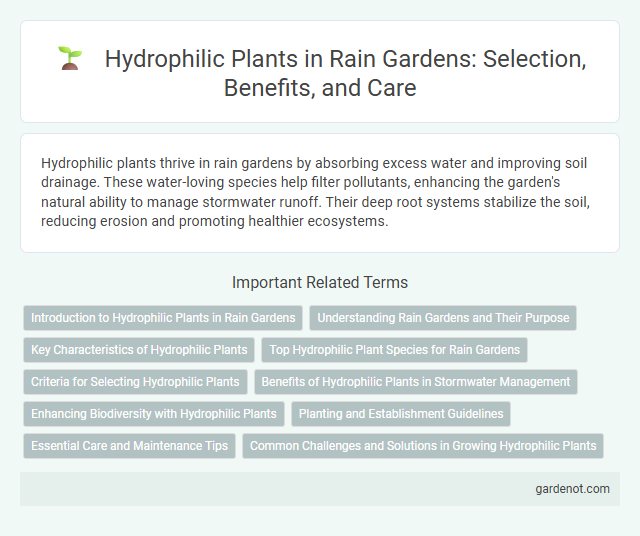Hydrophilic plants thrive in rain gardens by absorbing excess water and improving soil drainage. These water-loving species help filter pollutants, enhancing the garden's natural ability to manage stormwater runoff. Their deep root systems stabilize the soil, reducing erosion and promoting healthier ecosystems.
Introduction to Hydrophilic Plants in Rain Gardens
Hydrophilic plants, essential in rain gardens, thrive in consistently moist or water-saturated soils, aiding in stormwater absorption and filtration. Species such as pickerelweed, marsh marigold, and blue flag iris effectively reduce runoff by stabilizing soil and promoting infiltration. Incorporating hydrophilic vegetation enhances rain garden functionality by improving water quality and supporting local biodiversity.
Understanding Rain Gardens and Their Purpose
Hydrophilic plants thrive in rain gardens by efficiently absorbing excess stormwater, reducing runoff, and preventing soil erosion. These water-loving species promote natural filtration, improving water quality by trapping pollutants and sediments. Incorporating native hydrophilic plants enhances biodiversity while supporting the rain garden's primary goal of sustainable water management.
Key Characteristics of Hydrophilic Plants
Hydrophilic plants thrive in water-saturated soils, exhibiting specialized adaptations such as aerenchyma tissue for oxygen transport and shallow root systems to maximize nutrient absorption in wet conditions. These plants often display flexible stems and leaves that withstand flooding and promote gas exchange in saturated environments. Their ability to tolerate anaerobic soil conditions makes them essential for effective rain garden filtration and water management.
Top Hydrophilic Plant Species for Rain Gardens
Top hydrophilic plant species for rain gardens include Pickerelweed (Pontederia cordata), which thrives in saturated soils and attracts pollinators. Other highly effective plants are Swamp Milkweed (Asclepias incarnata) known for supporting monarch butterflies and Blue Flag Iris (Iris versicolor), valued for its water filtration capabilities. These species enhance rain garden function by absorbing excess water, reducing runoff, and improving habitat biodiversity.
Criteria for Selecting Hydrophilic Plants
Hydrophilic plants are chosen for rain gardens based on their tolerance to varying moisture levels, especially their ability to thrive in consistently wet or periodically flooded conditions. Selection criteria emphasize root structure for soil stabilization, native species adaptation to local climate, and contribution to water filtration by absorbing pollutants. Prioritizing plants like Carex, Lobelia cardinalis, and Juncus effusus ensures effective water management and ecosystem support in rain garden environments.
Benefits of Hydrophilic Plants in Stormwater Management
Hydrophilic plants play a crucial role in stormwater management by enhancing water absorption and reducing runoff, which mitigates flood risks and prevents soil erosion. Their deep root systems improve soil porosity and facilitate the filtration of pollutants, leading to improved water quality in urban and suburban environments. These plants also support biodiversity by providing habitat for aquatic and semi-aquatic species, contributing to a balanced and resilient ecosystem.
Enhancing Biodiversity with Hydrophilic Plants
Hydrophilic plants, thriving in wet conditions typical of rain gardens, play a crucial role in enhancing biodiversity by providing habitat and food sources for a variety of aquatic and terrestrial species. These plants improve water filtration and support pollinators, amphibians, and birds, creating a balanced ecosystem within urban landscapes. Incorporating native hydrophilic species such as pickerelweed, marsh marigold, and blue flag iris promotes resilience and maximizes ecological benefits.
Planting and Establishment Guidelines
Hydrophilic plants in rain gardens require well-drained, moist soil conditions during the planting and establishment phase to ensure root development and survival. Select native species adapted to seasonal fluctuations between wet and dry periods, planting in early spring or fall to maximize establishment success. Mulching around roots helps retain soil moisture and suppress weeds, enhancing plant vigor and resilience in the critical establishment period.
Essential Care and Maintenance Tips
Hydrophilic plants in rain gardens require consistent moisture and well-drained soil to thrive, ensuring optimal water absorption without root rot. Regular pruning removes dead foliage and promotes healthy growth, while occasional mulching preserves soil moisture and suppresses weeds. Monitoring for pests and adjusting watering schedules during dry spells are essential for sustaining vibrant, resilient hydrophilic vegetation in rain garden ecosystems.
Common Challenges and Solutions in Growing Hydrophilic Plants
Hydrophilic plants often face challenges such as root rot, nutrient imbalance, and fluctuating water levels in rain gardens. Ensuring proper soil drainage, selecting compatible plant species, and maintaining consistent moisture levels can mitigate these issues. Regular monitoring and adaptive care promote healthy growth and resilience in hydrophilic vegetation.
Hydrophilic plant Infographic

 gardenot.com
gardenot.com